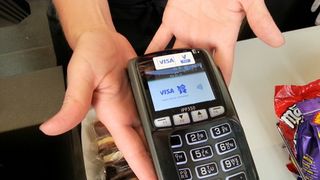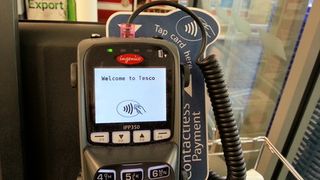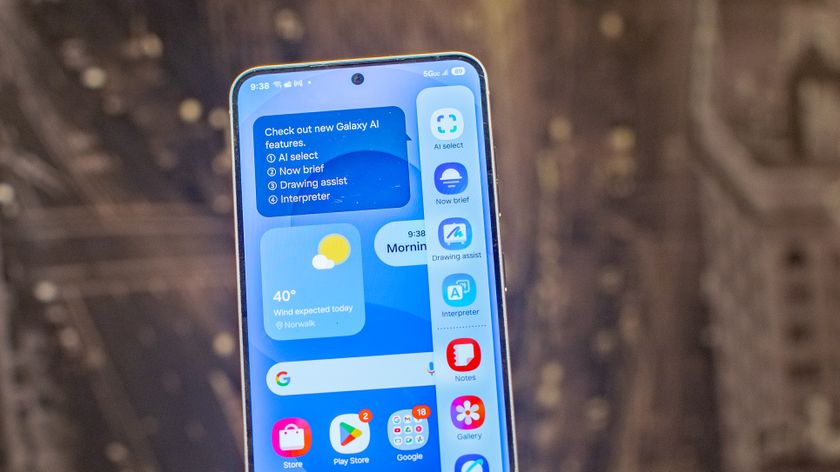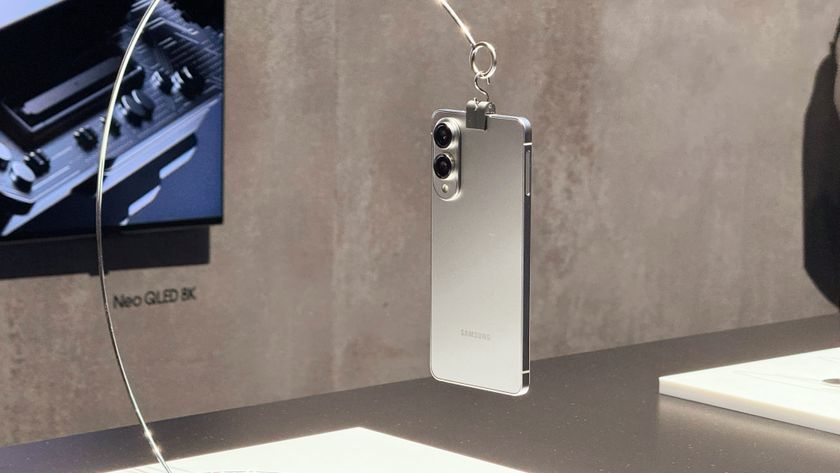Paying with your phone: TechRadar tests the Visa Olympic Samsung Galaxy S3
Are we ready to use our mobiles to buy goods?
If you're up to speed with the technology, then you'll be fine. Whipping out the phone didn't provoke the same confused or intrigued response as before, with the staff happy to pass over the terminal to make the payment – and as always, the transaction is done and dusted in a second or two.

There have been noted issues with the technology during the Olympics: Wembley Stadium's contactless payment system failed, causing only cash to be allowed. However, Visa was keen to point out it was the organiser's decision to stop using the system, not its own.
Speaking to Elaine behind the counter at the Olympic Park about the technology was interesting: she confirmed that while there had been some interest in using contactless cards (around three or four used over the course of two days) there had, understandably, been nobody using phones to pay for anything as yet.
That leads us nicely onto one of the biggest issues we faced during the trial: the lack of understanding most serving staff have about using contactless cards, let alone using a phone to pay for goods.
Sure, it's cool – but if we have to ask to have the machines enabled, then it presents a big barrier to the ease of use. The problem is it works in the same way as a card machine, where the till has to be told to accept a different kind of payment. Those systems that we ready to accept payment were fine – it's just not prevalent enough.
Visa is extolling the penetration of contactless cards (30 million in the UK by the end of the year) but the fact is people aren't using them, and that's mostly because they're not really sure how to use them.
For instance, when paying for part of a meal in a restaurant, the waiter picked up the card, placed it on the reader and £12 was debited. No asking if we wanted to pay via NFC, and similarly, no receipt, which will worry those new to the technology.
Get daily insight, inspiration and deals in your inbox
Sign up for breaking news, reviews, opinion, top tech deals, and more.
It took a fraction of the time to pay using NFC compared to paying via card, and it was excellent to see staff knowing how to use the system; but it should be the cardholder that gets to make the choice and tap the screen.
There's also the issue of knowing where contactless payments are available – you can check it out on the interactive Visa map (and there are loads) but having to trawl around and find places we could use the phone to pay for items was annoying.
This would be solved if it wasn't a pre-pay scheme, but we found ourselves buying coffees we didn't really want just to use up the money we'd preloaded.
The good news is we should see a swifter installation of these contactless payment terminals around the country: most of the time these are provided by banks to vendors, and given the banks also make money from each NFC payment, the desire to make it as prevalent as possible is clear to see.
There are already 120,000 of these terminals in place and their numbers are increasing all the time: the Post Office is going to fit them in all its branches over the coming months, and the likes of Marks and Spencer and Tesco are beginning to deploy the technology too – complete with signage denoting the new payment method.
Are we ready?
It's pretty clear we're standing on the precipice of contactless cards being used much more regularly in day to day life. The terminals are rolling out, education campaigns are underway to help consumers know what contactless actually means, and the means of actually paying are becoming more prevalent.
There also should be special strips for contactless payments; currently you're just supposed to wipe your device over a chip and pin machine and hope for the best. Flat services, like Oyster Card readers, would be great if there was space – or at least more direction on where to place the phone.

But it's early days for the system, and we saw a lot of benefit for the service. Security and finance management were high on the list; paying using the phone instead of cash meant that even if we lost the phone, we could stop the account before losing any money… and banks will guarantee the amount too.
Compare that to losing a wallet full of cash, and you can see why it's preferable… as long as you realise what's gone before the thief is buying the whole of McDonald's lunch on your behalf. (Although, in fairness, there is a limit on how much can be spent before a PIN has to be entered).
Would we consider ditching the card for a phone? Not just yet – we can't get over the fact we feel like utter fools asking to pay using a phone – but when most vendors are on board and up to speed, we'll be the first in line to sign our mobile up.

Gareth has been part of the consumer technology world in a career spanning three decades. He started life as a staff writer on the fledgling TechRadar, and has grew with the site (primarily as phones, tablets and wearables editor) until becoming Global Editor in Chief in 2018. Gareth has written over 4,000 articles for TechRadar, has contributed expert insight to a number of other publications, chaired panels on zeitgeist technologies, presented at the Gadget Show Live as well as representing the brand on TV and radio for multiple channels including Sky, BBC, ITV and Al-Jazeera. Passionate about fitness, he can bore anyone rigid about stress management, sleep tracking, heart rate variance as well as bemoaning something about the latest iPhone, Galaxy or OLED TV.











